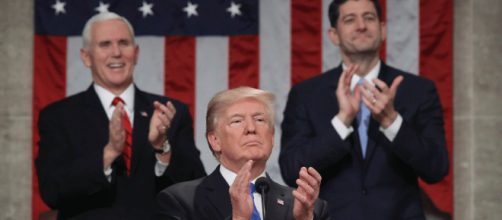It almost sounded like a joke. On Jan. 27 a senior White House official gave the press a heads-up about the president’s state of the Union speech, saying it would show trump to be “a great unifier.” In other words, the speech would be about him. And so it was. Despite numerous references to others, he kept applauding himself.
Peacemaker-in-chief
But “unifier”? How could that be? Nearly every day, Trump bad-mouths someone. Only last week, he tweeted one of his derisions, this one of the Democratic minority leaders in the Senate who tearfully mourned the travel ban.
He called him “Crying Chuck Schumer.” The unifier had spoken.
Short-term memory loss
Advance word about the speech also mentioned a reaching across the proverbial aisle in a spirit of bipartisanship, which seemed weird. Did Trump really think that benevolent words read off a teleprompter on a single night will erase a year’s worth partisanship, not to mention racism and sexism, which seems inherent in his thinking? It got weirder in the actual speech: “Set the politics aside and just get the job done,” he said as if he hadn’t shown zero interest in such a spirit. When the White House official told the press, “You can expect the president will be speaking from the heart,” all I could think was, let’s hope not.
State of confusion
Another head-scratcher came during Trump’s address when he intoned “Restore bonds of trust between government and America.” Who was he saying that to? He’s the one casting incessant doubt about his Justice Department, the FBI, the courts, the Senate and the House.
Words and pictures
It’s that double speak, his routine inversions that disturb and disturbs – saying opposite things as if they weren’t opposite. In that sense, Trump talks like Surrealist Rene Magritte paints, except that the artist had reasons. He’d purposely depict unrelated objects in odd settings, to spur viewers, he said, to let go of preconceived notions and appreciate the mystery of life instead.
The art of Trump
One of Magritte’s object lessons is a painting of a pipe that he calls “This is not a pipe.” The title contradicts what you see, but he’s right. The picture isn’t a pipe; it’s a picture of a pipe. His inversions make sense. Trump juggles reality and illusion but makes no sense. Given his commonality with Magritte, however, his habit may have a certifiable psychological basis.
Head trip
According to an Art Journal report ”Psychoanalysts and Art History,” Magritte’s manipulation of truth and reality stems from the trauma of a mother’s death. Psychoanalysts who studied bereaved children believe that Magritte's back and forth play with real and unreal is the result of “constant shifting back and forth from what he wishes: ‘mother is alive’ to what he knows – ‘mother is dead.’” Trump often speaks of his father, seldom of his mother. Is he in an arrested state of development? He sure acts like it.


